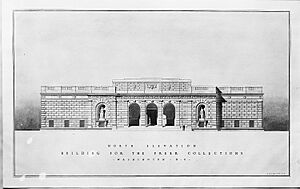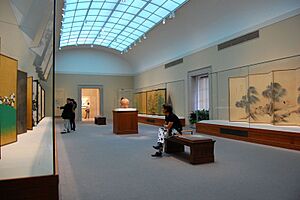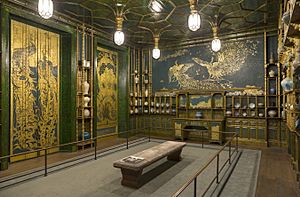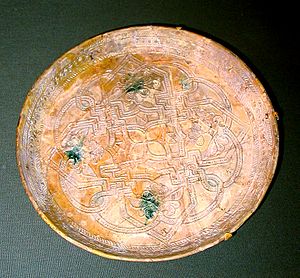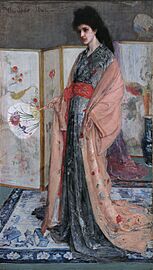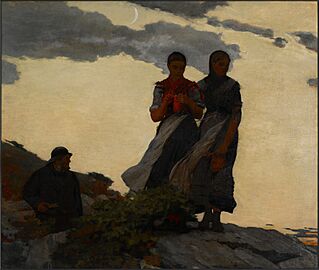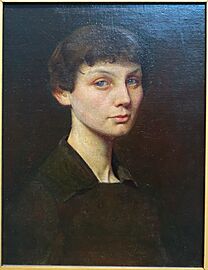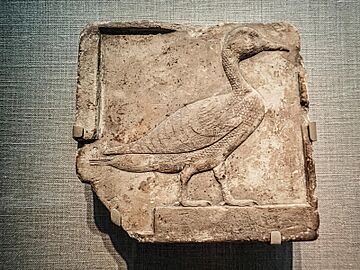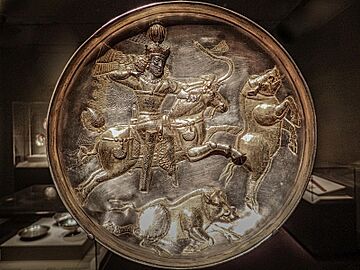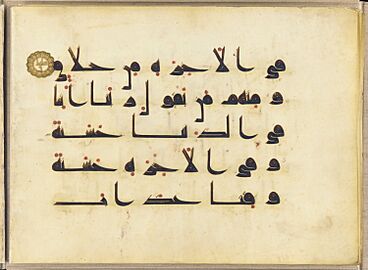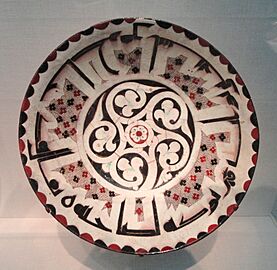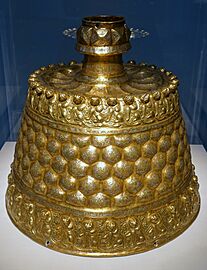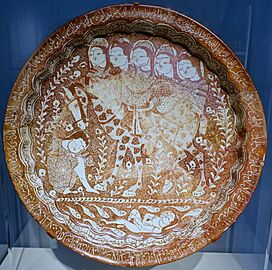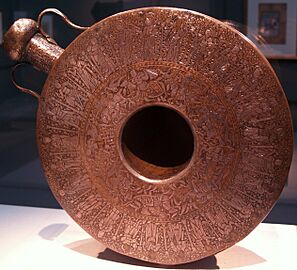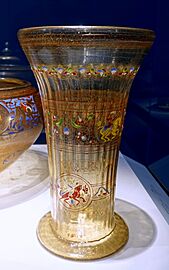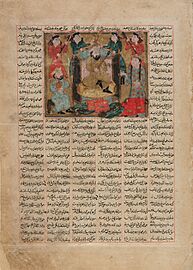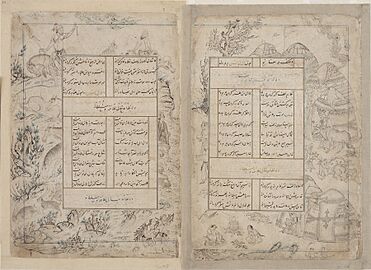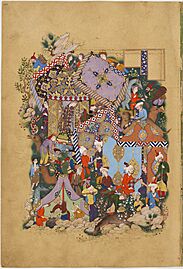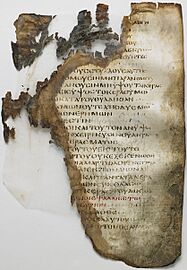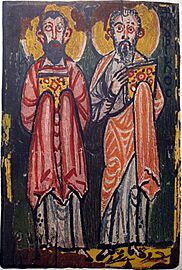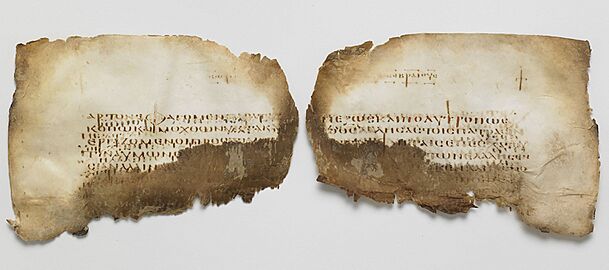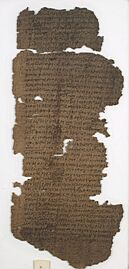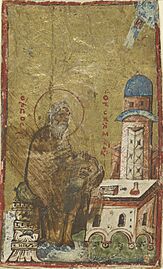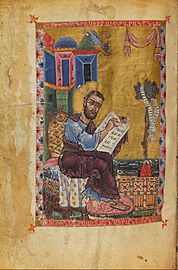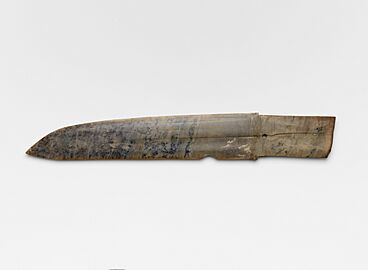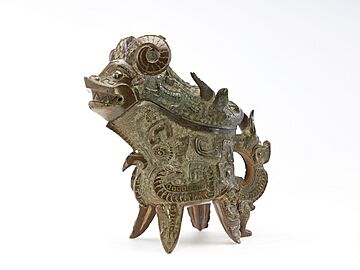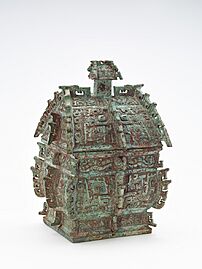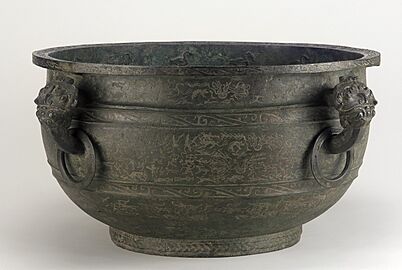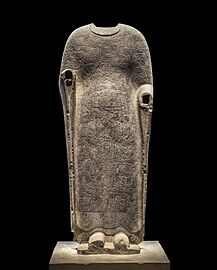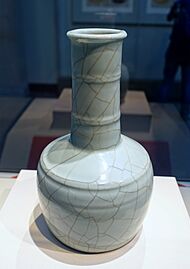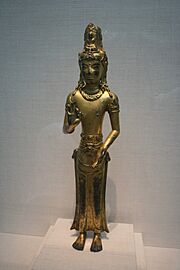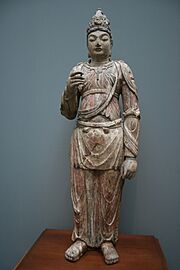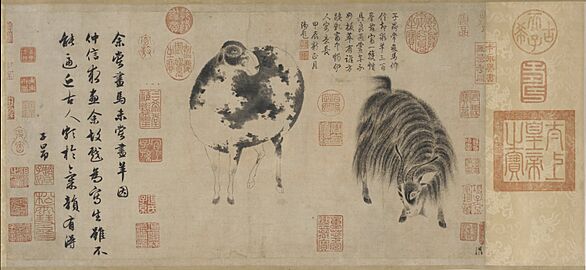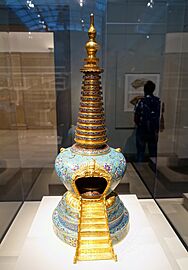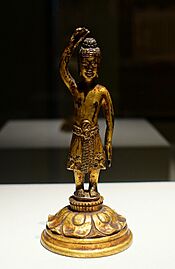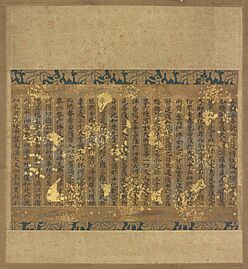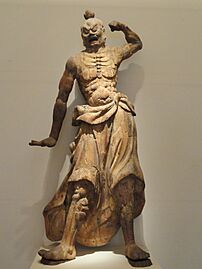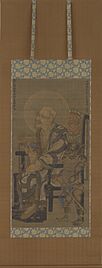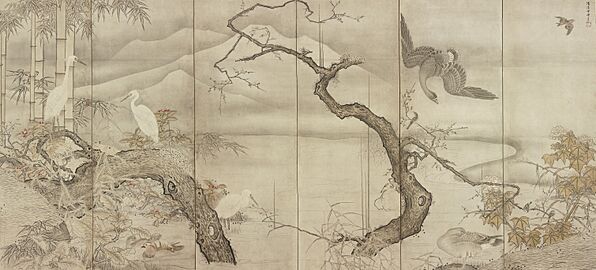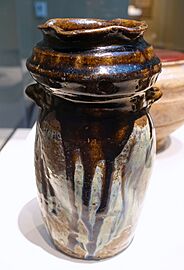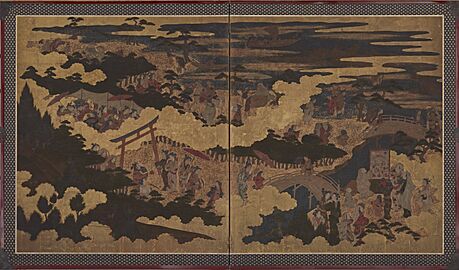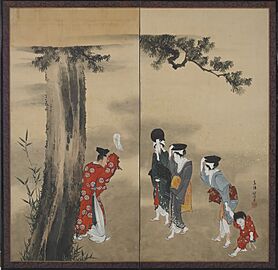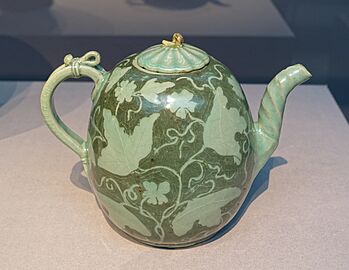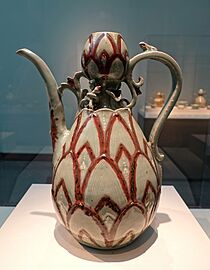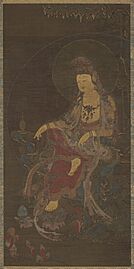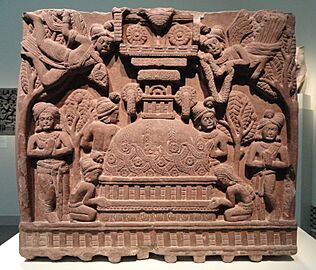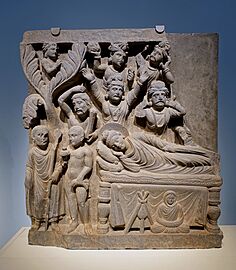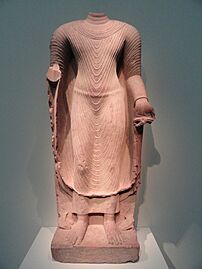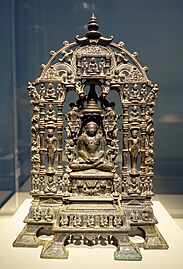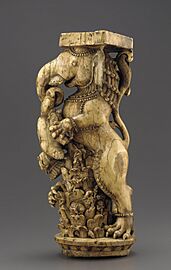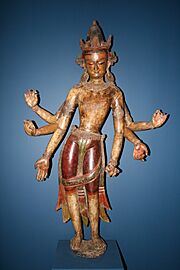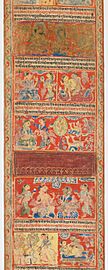Freer Gallery of Art facts for kids
| Established | 1923 |
|---|---|
| Location | 1050 Independence Avenue Washington, D.C. |
| Public transit access |
The Freer Gallery of Art is a famous art museum in Washington, D.C. that is part of the Smithsonian Institution. It focuses on Asian art. The Freer and its partner, the Arthur M. Sackler Gallery, together are called the National Museum of Asian Art. They have the largest library for Asian art research in the United States.
The museum's collection includes art from East Asia, South Asia, Southeast Asia, the Islamic world, the ancient Near East, and ancient Egypt. It also has an important collection of American art. The gallery is located on the National Mall and is open almost every day of the year for free.
The Freer holds over 26,000 objects that show 6,000 years of history. You can see everything from ancient stone sculptures to modern paintings. Some highlights include Chinese paintings, Korean pottery, Japanese screens, and Buddhist art. A famous American piece is Harmony in Blue and Gold: The Peacock Room by James McNeill Whistler.
The museum offers free tours, films, concerts, and talks. You can also see over 11,000 objects from the collection online.
Contents
History
How the Gallery Started
The gallery was created by Charles Lang Freer, a man from Detroit who made his fortune building railroad cars. Freer loved art and taught himself about it. He collected many works by the American artist James McNeill Whistler and became his friend and supporter.
In 1906, Freer offered his amazing art collection to the United States. He also gave money to build a museum and to buy more art in the future. He wanted the museum to focus on "very fine examples of Oriental, Egyptian, and Near Eastern fine arts."
President Theodore Roosevelt personally supported the project, which helped the Smithsonian accept the gift. Freer had some rules for his collection. For example, the art could only be shown in his gallery and not loaned to other museums. He wanted scholars to always have access to the art for study. Freer passed away before the museum was finished.
Building the Museum
Construction on the gallery started in 1916. It was delayed by World War I but was finally completed in 1921. The Freer Gallery of Art officially opened to the public on May 9, 1923.
The building was designed by architect Charles A. Platt. He was inspired by the beautiful palaces he saw in Italy. The outside of the museum is made of pink granite. Inside, the walls are limestone, and the floors are polished marble. The courtyard features a fountain and white marble walls.
In 1993, a major renovation connected the Freer to the nearby Arthur M. Sackler Gallery with an underground space. This gave the museum more room for exhibitions and storage.
The Museum Today
When it opened, the Freer was the Smithsonian's first museum just for fine arts. It was also the first created from a private collection. Today, the collection has grown to include almost 18,000 more works of Asian art since Freer's original gift.
The Freer and Sackler galleries are connected and share a director and staff, but their collections are kept separate. The Freer was closed for major renovations in 2016 and reopened in October 2017 with updated spaces.
Exhibitions
One of Charles Lang Freer's rules was that only art from his collection could be shown in the gallery. This means the museum doesn't borrow art from other places or lend its art out. Even with this rule, the Freer has so many objects that it can create amazing exhibitions that are known around the world. The museum also has many temporary exhibits that change over time, so there is always something new to see.
American Art at the Freer
Freer started collecting American art in the 1880s. After he met the artist James Abbott McNeill Whistler, who was inspired by Asian art, Freer also began collecting art from Asia. But he never lost his love for American art. He collected over 1,300 works by Whistler, which is now considered the best collection of his art in the world.
One of the most famous exhibits is The Peacock Room. It was once the dining room in a London home, and Whistler decorated it with beautiful green and gold peacock designs. Freer bought the entire room in 1904 and had it installed in the gallery. It is now on permanent display for everyone to enjoy.
The Freer also has art by other famous American artists like Thomas Dewing, Dwight Tryon, Childe Hassam, and John Singer Sargent.
Online Collections and Resources
The Freer and Sackler galleries offer many ways to explore their collections online. You can search for thousands of art objects on their website. They have also digitized old photographs, maps, and diaries from archaeologists. This helps researchers from all over the world study Asian art and culture.
The Freer|Sackler Library is the largest Asian art research library in the country. It has over 86,000 books, and many are in Asian languages. The library is open to the public and is a great resource for students and researchers.
Public Programs and Events
The museum has an auditorium where it hosts many free public programs. These include concerts, dance performances, lectures, and film festivals. The film series often highlights movies from different Asian cultures, such as Korea and Iran.
The museum also has a popular series called "Asia After Dark." These events open the museum in the evening for music, food, and fun. Free tours are offered every day to guide visitors through the galleries and special exhibitions.
Caring for the Art
From the very beginning, Charles Lang Freer hired experts from Japan to care for his paintings. Today, the museum has a special department for conservation and scientific research. The experts in this department, called conservators, work to protect and repair the artworks.
They use scientific methods to study the art and make sure it is preserved for the future. They care for objects in the collection, prepare them for display, and study new items the museum might want to acquire. This team helps keep the museum's treasures safe for everyone to see.
Gallery
American Art
-
The Princess from the Land of Porcelain by James Abbott McNeill Whistler. Oil on canvas, 1863 - 1865
-
Early Evening by Winslow Homer. Oil on canvas, 1881
-
Breakfast in the Loggia by John Singer Sargent. Oil on canvas, 1910
Ancient Egyptian Art
-
Head of a pharaoh wearing the White Crown (hedjet) of Upper Egypt. Diorite. Old Kingdom, 5th or 6th Dynasty (2494–2181 BC)
-
Miniature glassware vessels. New Kingdom, 18th Dynasty (1550–1307 BC)
-
Plaque depicting a goose. Limestone. 26th Dynasty (664-525 BC)
Ancient Near Eastern Art
-
Shapur Hunting Plate. Silver and gilt. Sasanian Empire, reign of Shapur II (301-379)
Arts of the Islamic World
-
Folio from the Quran manuscript. Ink, color and gold on parchment. Abbasid period, 9th-10th century
-
Samanid Bowl. Earthenware painted under glaze. 10th century
-
Candlestick. Brass inlaid with copper, silver, and black organic material. Seljuk period, c. 1150-1200.
-
Plate made by Abu Zayd Kashani. Lustreware. Kashan, December 1210
-
Beaker. Glass. Mamluk period, Syria, late 13th-century,
-
Sam granting an audience to Queen Sindukht, Folio from the "Freer Small Shahnama". Ilkhanid period, early 14th century
-
Folio from a Divan (collected poems) by Sultan Ahmad Jalayir, with calligraphy attributed to Mir Ali Tabrizi and drawings attributed to Abd al-Hayy. Jalayirid period, Baghdad or Tabriz, c. 1400
-
Plate. Iznik pottery. Ottoman period, İznik, early 16th century,
-
Majnun approaches the camp of Layli’s caravan by Shaykh Mohammad Sabzevari, Folio from the manuscript of Haft Awrang by Jami. Safavid period, 1556-1565
Biblical Manuscripts
-
Washington manuscript I. Greek parchment codex, containing Deuteronomy and Joshua. Early 5th century
-
Washington Manuscript II (Rahlfs 1219). Greek parchment codex of the Psalms. 5th century CE
-
Codex Washingtonianus. Greek parchment codex with Gospels. 4th or 5th century
-
Washington Manuscript IV (Codex Freerianus). Greek vellum codex. 5th century CE
-
Washington Manuscript V. Greek on papyri, Twelve Minor Prophets. 3rd century CE
-
St. John of the Ladder (Climacus): illustration from a Klimax manuscript. Byzantine period, early 12th century
-
Portrait of Saint Mark in Armenian Gospel manuscript. Yohanes, Armenia, 1253
Chinese Art
-
Dagger-axe with inscription of thirty characters. Jade (nephrite). Erlitou culture or early Shang dynasty, c. 2000 - c. 1400 p.n.e.
-
Ritual wine ewer (guang) with taotie, dragons, and real animals. Late Shang dynasty, 11th century BCE
-
Fangyi with cast inscription of 187 characters which commemorates three days of meetings and ceremonies held in Chengzhou during the reign of King Zhao (977/75–957 BC)
-
Basin (jian) with narrative scenes. Bronze. Eastern Zhou, 5th century BCE
-
Disk (bi) with knobs, feline and dragon. Nephrite. Han dynasty, between 100 and 220 CE
-
Lidded box in the form of a melon with grapevines and knob in the shape of a rodent. Cast and hammered silver with chased and ring-punched decoration and leaf gilding. Tang dynasty, late 7th-early 8th century
-
Guan ware vase. Song dynasty, 12th century
-
Bodhisattva Guanyin. Gilded domeykite. Dali Kingdom, 12th century
-
Standing Bodhisattva. Wood, Jin dynasty
-
Sheep and goat by Zhao Mengfu. Handscroll. Yuan dynasty, c. 1300
-
Dish with copper-red glaze, and a Xuande mark in cobalt oxide on the base. Ming dynasty, 1426-1435
-
Cloisonne stupa with gilt ornaments. Qing dynasty, mid- to late 18th century
Japanese Art
-
The Buddha at Birth. Gilt bronze. Asuka period, 7th century
-
Lotus Sutra. Ink, gold, silver, and color on paper. Late Heian period, mid 12th century
-
Guardian figure. Wood. Kamakura period, early 14th century
-
Buddhist Luohan by Ryōzen. Hanging scroll. Nanboku-chō period, mid-14th century
-
Birds and Flowers of the Four Seasons: Autumn and Winter by Sesshū Tōyō. Screen (six-panel). Muromachi period, late 15th-early 16th century
-
Karatsu Vase, with lacquer lid for use as tea ceremony water jar. Momoyama period, 1596-1615
-
A festival at the Sumiyoshi Shrine. Color and gold on paper. Edo period, early 17th century
-
A Shinto Priest, Three Women and a Child by Katsushika Hokusai. Ink, gold, and color on paper. Edo period, ca. 1799-1801
Korean Art
-
Water-moon Avalokiteśvara (Suwol Gwaneum bosal). Ink, color and gold on silk. Late Goryeo period, mid-14th century
South Asian & Himalayan Art
-
One face of a fence-rail from Bharhut: Worship at a Stupa. Sandstone. Madhya Pradesh, India, early 2nd century BCE
-
Four Scenes from the Life of the Buddha - (Detail) Parinirvana. Stone. Gandhara art, Pakistan or Afghanistan, Kushan period, late 2nd-early 3rd century
-
Standing Buddha. Red sikri sandstone. Mathura, Gupta period, 320-485
-
Queen Sembiyan Mahadevi as the Goddess Parvati.jpg
Queen Sembiyan Mahadevi as the Goddess Parvati. Bronze. Chola dynasty, 10th century
-
Avalokiteshvara, the Bodhisattva of Compassion, Guge kingdom, 1000-1050 AD, Nagari, west Tibet, brass alloy with copper and tin inlay, colored wax, traces of gilding, and pigment - Freer Gallery of Art - DSC05209.JPG
The Bodhisattva Avalokiteshvara. Brass alloy with copper and tin inlay. Western Tibet, 11th century
-
Jain shrine of Parshvanatha. Copper alloy. Khajuraho region, 1097
-
The Buddha distributes honey, from a Prajnaparamita manuscript. Opaque watercolor and ink on palm leaf. West Bengal, 12th century
-
Bodhisattva White Avalokiteshvara (Amoghapasha Lokeshvara). Wood and polychromy. Nepal, 14th century
-
Vasantavilas (detail). Scroll. Opaque watercolor, ink and gold on paper mounted on cloth. Gujarat, 1451
Southeast Asian Art
-
Standing Buddha and tabernacle. Bronze. Thailand, 12th-13th century
-
Dish. Stoneware with white slip and cobalt pigment under colorless glaze. Red River Delta kilns, Lê dynasty, 15th-century
-
Head of a Buddha. Bronze with glass and mother-of-pearl. Thailand, Ayutthaya period, ca. 1700
See also
 In Spanish: Galería Freer para niños
In Spanish: Galería Freer para niños
- Biblical Manuscripts in the Freer Collection
- Pewabic Pottery
- Ernst Herzfeld and Persepolis
- Zhou Jichang
- Charles Lang Freer medal
- Lin Tinggui
- J. Keith Wilson


